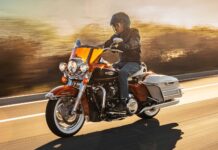
August 14, 2016, was my Harley-Davidson Ultra Classic’s 20th birthday. I know because I went to the dealership and had them look it up. Therefore as a birthday present I cleaned and polished everything, did all the proper maintenance, checked and repaired anything that needed to be checked and repaired and now it is clean and pretty and runs like a top.
A few months ago I added a trailer hitch, purchased a small trailer to haul my camping gear and told everyone I was going out on the road. “Expect me when you see me.”
Yesterday morning, before daylight, to beat the heat and the traffic, I headed north out of Los Angeles. At Castaic, I got off the freeway, found a nice spot under a tree away from the freeway, took out my stove, made myself a cup of coffee and watched the sunrise. It was a spot not far from the beginning of the original, old Ridge Route, the one built in 1915. The old road is one and a half cars wide, follows the contours of the mountain, twisty as hell, pock marked with potholes every 10 feet, extremely dangerous and for nearly 20 years was the only way out of the Los Angeles Basin, over the San Gabriel and Tehachapi Mountains and into the Great San Joaquin Valley. I’ve been on it several times but currently it is completely closed due to some serious washouts from past storms. Doesn’t look like it will ever be reopened.
While watching my little single burner stove sitting on top of the trailer perking coffee, I remembered my father telling me in generalities about how his family left the Dust Bowl in 1930 and all about his first trip over the Ridge Route.
For those of you who have read John Steinbeck’s 1939 Pulitzer winning novel, The Grapes of Wrath, or seen the John Ford classic movie, you have seen how my family came from Texas to California.
In case you have forgotten, the story is about the “Joads,” poor tenant dirt farmers who lost their farm during the Great Depression of the 30’s, tied everything they owned on a Model T flatbed truck and traveled Route 66 west for the golden promise of California.
My family, like thousands of other “Okies,” came to California, “the land of milk and honey,” because they had been told they could make a living working in the fields and picking fruit.
For me, watching the movie is like genealogy. For my father, who was a teenager clinging to the back of the flatbed truck, it was difficult family history.
Some time ago, after finding a box of old photos that had belonged to my aunt, the pictures sparked very specific paternal stories about the trip.
Fascinated, I asked questions concerning every print. “Who is this? Where were you? How long had you been on the road?”
One photo was of the truck parked on a sandbar in the Colorado River while the entire family was having a picnic. “Dad, why were you parked in the river?”
“Hickory wheels, wooden wheels on old Model T’s, would loosen up in the desert because there is no humidity. So you parked in the river and soaked them good.”
There was a photo of an old Victorian wood frame house. “Dad, whose house is that?”
“One of our distant relatives had a boarding house on the top of Bunker Hill in downtown L.A.” (The top of Bunker Hill no longer exists.) “We stayed there for a few days right after the family got to California, but she had her own family and couldn’t put us up for long so we headed out for the Central Valley.”
Another pic of a campsite elicited a further query: “Where was this campsite?”
Dad studied it for a long while and finally said, “I think that is our first campsite at the bottom of the Ridge Route, south side, about where Castaic is now.” He looked at it some more and agreed with himself that it was indeed their camp at the bottom of the old road.
“Why did you camp there? It’s not that far from downtown.”
“Not now, but then it was a full day’s travel for an overloaded, beat-up Model T truck on crappy roads. It took us all day to get from downtown to the bottom of the hill.”
“You’re kidding.”
“No, I am not kidding. It took all day to the bottom of the Ridge Route, all the next day to get up to the top of the hill and it took two days to get down the north side, the side they call the Grapevine.”
“Why so long?”
“It was all we could do to make it up that mountain. Every so often we stopped for water, let the engine cool off, repaired fan belts and fixed flat tires. Once at the top, coming down was even more dangerous. Because it was so overloaded, we kept burning out the brake bands on the old Ford truck and had to fix them with our belts or any leather we could find, tried again, burned them up again, fixed them again and tried again. Grandma got so scared when the brakes gave out that she refused to get back in the truck and ended up walking down the mountain.”
“Once you got to the flat valley floor how fast could you go?”
“Oh, once off the Grapevine, on our way to Bakersfield we could make really good time, 25 mph.”
“One day to the south side camp, one day to the top and two days down.”
“Yep.”
“Four days to Bakersfield … what is that, 110 miles?”
“About … But in the early days, a nasty 110 miles”
It was pleasant remembering the bygone conversation with my dad.
Finishing my cup of coffee, I packed my little stove, put away the coffee makings, fired up my Harley and snaked over the mountain on Interstate 5 where there is hardly a perceptible turn. To the east, if you know where to look, you can still see the old Ridge Route cut in the side of the mountain.
A motorcycle pulling a trailer up the Ridge Route and down the Grapevine on a smooth highway isn’t like an overloaded Model T Ford truck on a road built in 1915. However, today, I was with my dad, grandpa, grandma and the extended family as they tried to get to the vegetable fields and fruit orchards of the Great San Joaquin Valley.



















